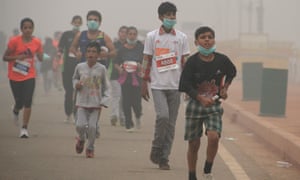https://www.theguardian.com/world/2016/nov/06/delhi-air-pollution-closes-schools-for-three-days
Indian government declares Delhi air pollution an emergency
Capital’s schools closed for three days and building work halted as harmful pollutants reach level more than 16 times safe limit

The Indian government has declared severe levels of toxic air pollution in Delhi an “emergency situation” as administrators announce a plan to temporarily shut construction sites and a coal-fired power station to bring the situation under control.
Schools in the capital will be closed for three days and traffic may be rationed, following six days of heavy smog and concentrations of harmful particles so high they cannot be measured by most air quality instruments.
The level of PM2.5 pollutants, which are the most harmful because they can reach deep into the lungs and breach the blood-brain barrier, have reached at least 999 in parts of the city this week, more than 16 times the safe limit of 60.
On Sunday, Delhi’s chief minister, Arvind Kejriwal, announced emergency measures aimed at protecting residents, including a five-day ban on construction and demolition, thought to be a major contributor to pollution levels.
Bulldozers are to be used to put out fires at the Bhalswa landfill, which constantly smoulders.
Kejriwal said: “People should stay home as much as they can [and] work from home.”
A coal-fired power station in Badarpur, south-east Delhi, will stop operating for 10 days, along with diesel generators in the city.
Kejriwal has called on neighbouring states to enforce laws against burning agricultural waste.
Around this time each year, hundreds of thousands of farmers in Haryana and Punjab set their fields on fire to dispose of crop remnants, sending smoke billowing across India’s northern plains.
The Delhi government is preparing to reintroduce a temporary scheme to only allow cars to drive on odd or even days depending on the last digit of their registration numbers.
Airborne pollution in Delhi rarely stays within safe levels, even during summer, when winds are stronger and dust and droplets disperse more easily in the hot air.
It is traditionally worst in the winter months, beginning with Diwali, when hundreds of thousands of fireworks are let off across the city. They leave a haze that usually lasts for two or three days, but has persisted for almost a week this year.
The Centre for Science and Environment, a Delhi-based NGO, has said the air quality is the worst the Indian capital had seen in 17 years.
Hospitals in the city have reported increased admissions of people suffering respiratory diseases – of which India has the highest rate in the world, with 159 deaths per 100,000 people in 2012, according to the World Health Organisation.
Children are particularly vulnerable, a 2015 study finding about half the city’s 4.4 million schoolchildren had stunted lung development and would never completely recover.
Arti Maria, an associate professor of paediatrics at the Ram Manohar Lohia Hospital told local media the air was “killing presently”.
“[The] presence of even little smoke is considered harmful for newborn and toddlers. The air quality right now can lead to slow brain development, mental irritation and psychological problems,” she said.
Businesses are reportedly suffering as a result of this week’s fog and the low visibility was blamed for a 20-car pile up a major Delhi expressway on Thursday.
The city struggled with poor air quality in the 1990s but managed to clear its atmosphere by raising emissions standards for vehicles, mandating its fleet of taxis and buses use compressed natural gas and moving some heavy industry to the outskirts of the city.
Other than smoke from fires in neighbouring states, the city’s poor air is attributed to a combination of road dust, exhaust fumes, industrial emissions and open fires, including those lit by poorer residents to cook and keep warm.






